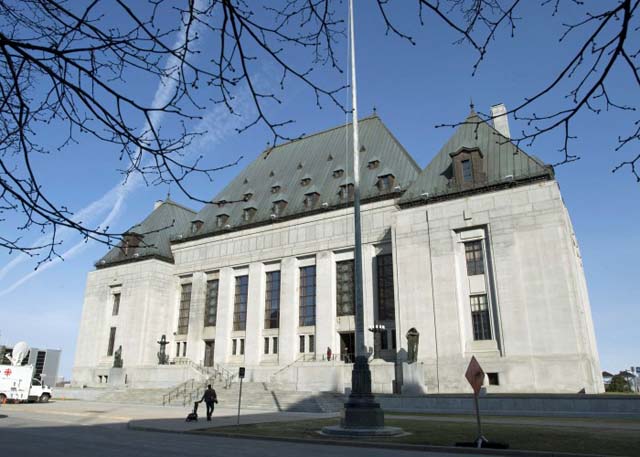

on Grain Regs
Ottawa Ontario - The Canadian Transportation Agency (CTA) did not act independently when it changed regulated interswitching distances during the
grain transportation crisis of 2013-2014, lawyers for Canadian Pacific Railway argued in Canada's top court Wednesday.
In front of the nine Supreme Court justices, lawyer Douglas C. Hodson argued the agency's decision to extend rail interswitching distances from 30 kilometres
to 160 kilometres across the Prairies in 2014 was done on the orders of the federal government and cabinet, rather than the agency.
Interswitching lets farmers and shippers ask a railway, for a fee, to move their product to a junction with another railway, provided the junction falls within
the prescribed radius.
The decision to extend the limit under the Fair Rail for Grain Farmers Act, emergency legislation implemented by the federal Conservatives during the 2013-2014
grain crisis, was hotly contested by Canada's two largest railways, Canadian National (CN) and Canadian Pacific (CP).
On Wednesday, Hodson argued the CTA did not "independently exercise its power" in deciding the 160-kilometre distance.
The agency, he told the court simply followed government orders "instead of forming its own opinion."
"Did they (the agency) make their own decision on the 160 kilometres or not?," Hodson said.
"We say they didn't."
The CTA, Hodson argued, posted on its web site in June, at the start of its consultation process, that it was required to extend the interswitching distance to
160 kilometres, a post, Hodson said, that demonstrates that the agency "felt compelled" to implement the 160 kilometre radius.
CP, Hodson added, wrote to the agency and said the agency was not required to follow through on the 160 kilometre limit.
Those correspondences, he told the court, "were ignored."
Not so, government lawyers refuted.
"CP was heard," Mark Kindrachuck, lawyer for the Attorney General argued, noting the railway made four submissions to the agency, including oral
arguments.
Further, the 160 kilometre limit was explicitly included in the regulations, rather than the bill itself, to provide more "flexibility," Kindrachuck
said, given the railways concerns.
"It's a lot easier to change if it's in the regulations," Kindrachuck said, noting the entire Fair Rail for Grain Farmers Act was designed as
"temporary" legislation.
The agency, he insisted, did nothing wrong.
"There was nothing improper that they (the agency) did with regards to the 160 kilometre distance," Mark Kindrachuck, lawyer for the Attorney
General, argued.
The distance, he said, was "interpreted as government policy," noting the agency is "entitled" to take policy instruction from
parliament.
The intent to change the limit to 160 kilometres, Kindrachuck told the court, was publicly known, having been discussed in parliamentary debate and at
committee.
The Canadian public, he insisted, knew the federal government wanted the limit set to 160 kilometres.
"It's not as if this was a secret hallway conversation," he said.
"It was clearly a cabinet decision."
Former transportation minister Lisa Raitt confirmed to iPolitics Wednesday that the 160 kilometre distance was decided by cabinet.
Under the legislation, the final decision on the interswitching distance rested with cabinet, a point raised by several justices during Wednesday's
hearing.
"Is your position that the government can amend a decision by the government?," Justice Rosalie Silberman Abella asked.
"That's what the section says," Kindrachuck said, referring to section 43 of the Canada Transportation Act, which says the governor in council may
issue policy directions to the agency.
"All the agency did was act within parliament's clearly expressed intention," Kindrachuck said.
The agency, he told the court, received at least one submission during its consultation process that considered different interswitching limits.
The chart, put forward by Quorum Corporation (a grain monitor) highlighted how many grain elevators would be accessible if the radius was set at 30 kilometres,
120 kilometres, and 160 kilometres, he said.
The CTA's lawyer, Valerie Lagace, further noted many stakeholders indicated in their submissions that they were in favour of the 160 kilometre
radius.
The 2013-2014 grain crisis saw millions of tonnes of Prairie grain left stranded in on-farm bins and grain elevators for months because of poor rail service,
frigid temperatures, a bumper crop, and major miscommunications across the supply chain.
The backlog is estimated to have cost Canada's grain industry between $5 billion and $8 billion dollars.
Canada's grain transportation system is currently undergoing a federal review.
Committee Chair David Emerson must submit his final report to Transport Minister Marc Garneau by the end of December.
Kelsey Johnson.
OKthePK Joint Bar Editor: Why is this case so important to the railways? Earlier this year the CTA granted Parrish & Heimbecker an interswitching order which required CP to haul P&H's cars from Milk River to Coutts for the statutory rate of $315 per car instead of CP's commercial rate of $1,373 per car, a substantial difference in cost. In January CP appealed that CTA order in the Federal Court and lost.


